This information will help you manage trismus after treatment for head and neck cancer. Trismus, also known as lockjaw, is when you have trouble opening your mouth fully.
After surgery or radiation therapy to your head and neck, your jaw may feel tight. Your mouth may be hard to open. Following the instructions in this resource will help relax your jaw muscles. This will help your mouth and jaw move and work like they did before your treatment.
About Your Jaw
Your jaw is made up of a pair of bones. These bones form the framework of your mouth and teeth (see Figure 1).
- Your maxilla is your upper jawbone.
- Your mandible is your lower jawbone.
- Your temporomandibular joint (TMJ) is where your mandible connects to your skull.
- Your masseter muscle is the muscle that connects your mandible to your skull.
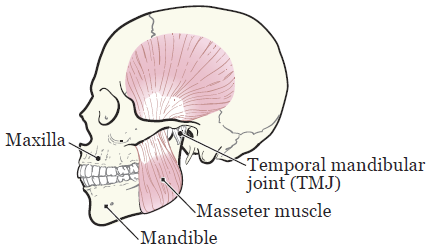
Many muscles and nerves around your jaw work together to open and close your mouth. Most people can open their mouth 35 to 55 millimeters (1.4 to 2.2 inches). This is about the width of 3 fingers (see Figure 2).
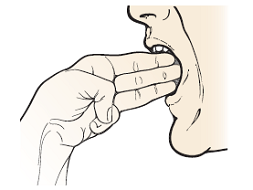
About Trismus
Trismus can happen anytime during, right after, or even years after your treatment. It can happen:
- If you have a tumor in the bones, muscles, or nerves that open your mouth.
- After surgery to your head and neck.
- After radiation therapy to your head and neck.
- After chemoradiation (KEE-moh-RAY-dee-AY-shun) therapy to your head and neck. Chemoradiation is when you receive chemotherapy along with radiation therapy.
These cancer treatments can cause fibrosis (fy-BROH-sis), which is an abnormal thickening or scarring of tissue. Fibrosis can develop as your tissues start to heal after surgery. It can also build up years after radiation therapy or chemoradiation therapy.
Trismus can get in the way of your daily activities and affect your quality of life. You may have problems with:
- Oral hygiene (cleaning your mouth and teeth). This can lead to bad breath, cavities, and infections.
- Chewing and swallowing. This can make it hard to eat and drink.
- Talking.
- Kissing.
- Having a breathing tube placed (for example, if you ever need general anesthesia).
- Having routine dental treatment.
- Feeling anxious (nervous or worried) or depressed (unhappy).
Once trismus develops, depending on how bad it is, it can be very hard to treat and manage. It’s important to identify trismus as soon as it develops, so you can get the right treatment for it.
How to Manage Trismus
There are 5 main ways to help manage trismus:
- Massage (gently rub) your jaw muscles.
- Exercise your jaw muscles.
- Keep good posture.
- Keep good oral hygiene.
- Use jaw mobilizing devices, if needed.
Even if you do not have any symptoms of trismus, you should do these things. They are important in helping your mouth move and work like it did before your treatment. If you do develop trismus, doing these things will help manage your symptoms.
Follow the instructions in the sections below. If you had surgery, ask your healthcare provider if it’s safe before you start.
Massage your jaw muscles
Place your index (pointer) and middle finger on your cheekbone. Keeping your lips together, relax your jaw (don’t clench your teeth).
Run your fingers down over your masseter muscle, which ends at your bottom jaw (see Figure 3). As you move your fingers, find areas that feel tender or tight. Massage these areas with your fingers in a circular motion for 30 seconds. Do this 2 to 3 times every day.
Try not to clench your jaw when you’re stressed or out of habit. This will help keep your jaw muscles relaxed.
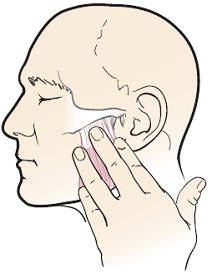
Exercise your jaw muscles
Your healthcare provider will tell you when to start doing these exercises. Follow their instructions. Starting too soon or too late can affect how well your mouth and jaw will work in the future.
Follow these tips when doing your exercises.
- It may be helpful to use a timer or clock to make sure you hold the stretches long enough.
- Breathe normally. Do not hold your breath during the exercises.
- Do the exercises slowly and smoothly. Do not make any fast or jerky movements.
- Watch your movements in a mirror to make sure you’re doing them correctly.
You can do these exercises while sitting or standing. When doing these exercises, you should feel a gentle stretch. They should not cause pain. If an exercise is causing pain or discomfort, try doing it more gently. If you still have pain or discomfort, stop right away and call your healthcare provider.
Active range of motion and stretching exercises
Do these exercises 3 times every day. Hold your head still while doing them.
- Open your mouth as wide as you can, until you feel a gentle stretch but no pain (see Figure 4). Hold this stretch for 10 seconds, then relax. Take 1 full breath between each repetition. Repeat this 5 times.
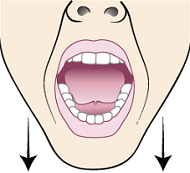
Figure 4. Mouth open wide - Move your lower jaw to the left (see Figure 5). Hold this stretch for 3 seconds, then relax. Take 1 full breath between each repetition. Repeat this 5 times.
- Move your lower jaw to the right (see Figure 6). Hold this stretch for 3 seconds, then relax. Take 1 full breath between each repetition. Repeat this 5 times.
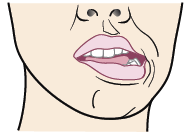
Figure 5. Move your jaw to the left 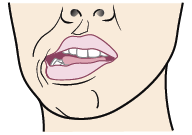
Figure 6. Move your jaw to the right
Passive stretching exercise
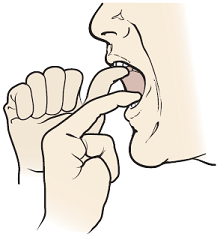
Do this exercise 3 times every day.
- Put on a pair of disposable medical gloves. If you do not have gloves, wash your hands well with soap and water. Wet your hands and apply soap. Rub your hands together well for at least 20 seconds, then rinse. Dry your hands with a paper towel and use that same towel to turn off the faucet. If you don’t have paper towels, it’s OK to use clean cloth towels. Replace them when they are wet.
- Place your thumb under your top front teeth.
- Place the index (pointer) finger of your other hand on your bottom front teeth (see Figure 7).
- Open your mouth as wide as you can. Push your fingers gently against your teeth to give extra resistance. This will help to keep your mouth from closing. You should feel a gentle stretch, but no pain. Hold this stretch for 5 to 10 seconds, then relax. Take 1 full breath between each repetition. Repeat this 5 times.
Keep good posture
Good posture means sitting and standing with your ears, shoulders, hips, knees, and ankles aligned (see Figure 8). You need to keep your neck and shoulders strong and flexible to have good posture. The following exercises will help you do this.
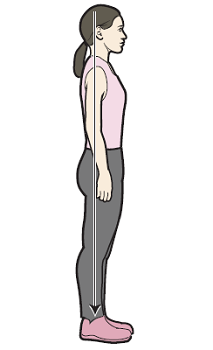
You can do them while sitting or standing with your arms at your sides. Try to check your posture at least once an hour while you’re awake. It’s very important to do this when you’re sitting for a long time, such as working in front of a computer.
Neck stretches
Do these exercises once a day.
Do these exercises until you feel a gentle stretch or pull. You should not feel pain when doing them.
- Bend your head forward (see Figure 9). Hold this position for 30 seconds, then relax. Take 1 full breath between each repetition. Repeat this 5 times.
- Bend your head backward (see Figure 10). Hold this position for 30 seconds, then relax. Take 1 full breath between each repetition. Repeat this 5 times.
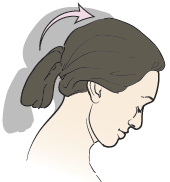
Figure 9. Bend your head forward 
Figure 10. Bend your head back - Turn your head to the right (see Figure 11). Hold this position for 30 seconds, then relax. Take 1 full breath between each repetition. Repeat this 5 times.
- Turn your head to the left (see Figure 12). Hold this position for 30 seconds, then relax. Take 1 full breath between each repetition. Repeat this 5 times.
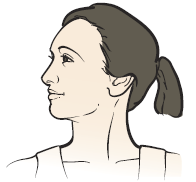
Figure 11. Turn your head to the right 
Figure 12. Turn your head to the left - Bring your left ear to your left shoulder (see Figure 13). Hold this position for 30 seconds, then relax. Take 1 full breath between each repetition. Repeat this 5 times.
- Bring your right ear to your right shoulder (see Figure 14). Hold this position for 30 seconds, then relax. Take 1 full breath between each repetition. Repeat this 5 times.
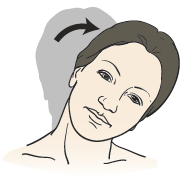
Figure 13. Bend your head to the left 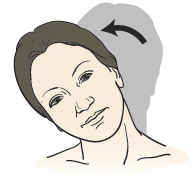
Figure 14. Bend your head to the right
Chin tuck
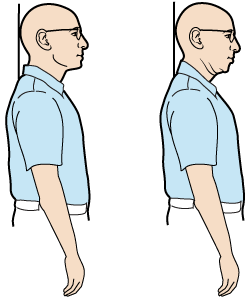
Do this exercise 3 times every day.
- Sit or stand with your back and head leaning against the wall.
- Tuck your chin in and try to flatten the back of your neck against the wall (see Figure 15). Hold this position for 5 seconds, then relax.
- Return to the starting position.
- Take 1 full breath between each repetition. Repeat this 10 times.
Shoulder blade squeeze
Do this exercise 3 times every day.
- Tuck your chin in (just like in the chin tuck exercise above).
- Push your shoulders down and away from your ears. This stops you from shrugging.
- Squeeze your shoulder blades together as tightly as possible (see Figure 16). Hold this position for 5 seconds, then relax.
- Return to the starting position.
- Take 1 full breath between each repetition. Repeat this 10 times.

Keep good oral hygiene
- Brush your teeth and tongue when you wake up, after each meal, and before you go to bed.
- If you have removable dentures or a dental prosthesis, take it out and clean it each time you clean your mouth. Do not sleep with it in your mouth.
- Floss your teeth once a day before you go to bed.
Use jaw mobilizing devices
A jaw mobilizing device is a handheld device that helps to stretch your jaw. Some examples of jaw mobilizing devices are:
- The TheraBite® Jaw Motion Rehabilitation System™.
- The OraStretch® Press System.
- The Jaw Dynasplint® System.
Using a jaw mobilizing device, along with exercising your jaw muscles, can help:
- Improve your jaw’s range of motion.
- Strengthen your jaw muscles.
- Reduce pain and swelling.
Your healthcare provider will tell you if you need to use a jaw mobilizing device. They will recommend one that is right for you and give you instructions on how to use it.
If You Develop Tightness When Opening Your Mouth
The earlier you start treatment for trismus, the easier it will be to help your jaw work better. If you notice any tightening in your jaw, call your healthcare provider right away. They can refer you to a specialist, such as:
- Physical therapists, speech and swallowing specialists, or both. They can help you keep your ability to open your mouth. They can also help you get back any ability you may have lost. They use many techniques, such as exercise, stretching, and massage. They may also recommend special jaw mobilizing devices to help you open your mouth.
- Rehabilitation medicine doctors. They check to see how well you can open your mouth. They may give you medication for pain or spasms (sudden intense cramping in your muscle), suggest other treatments, or recommend medical devices to help you.
Your healthcare provider will talk with you about which referral(s) may be most helpful for you.